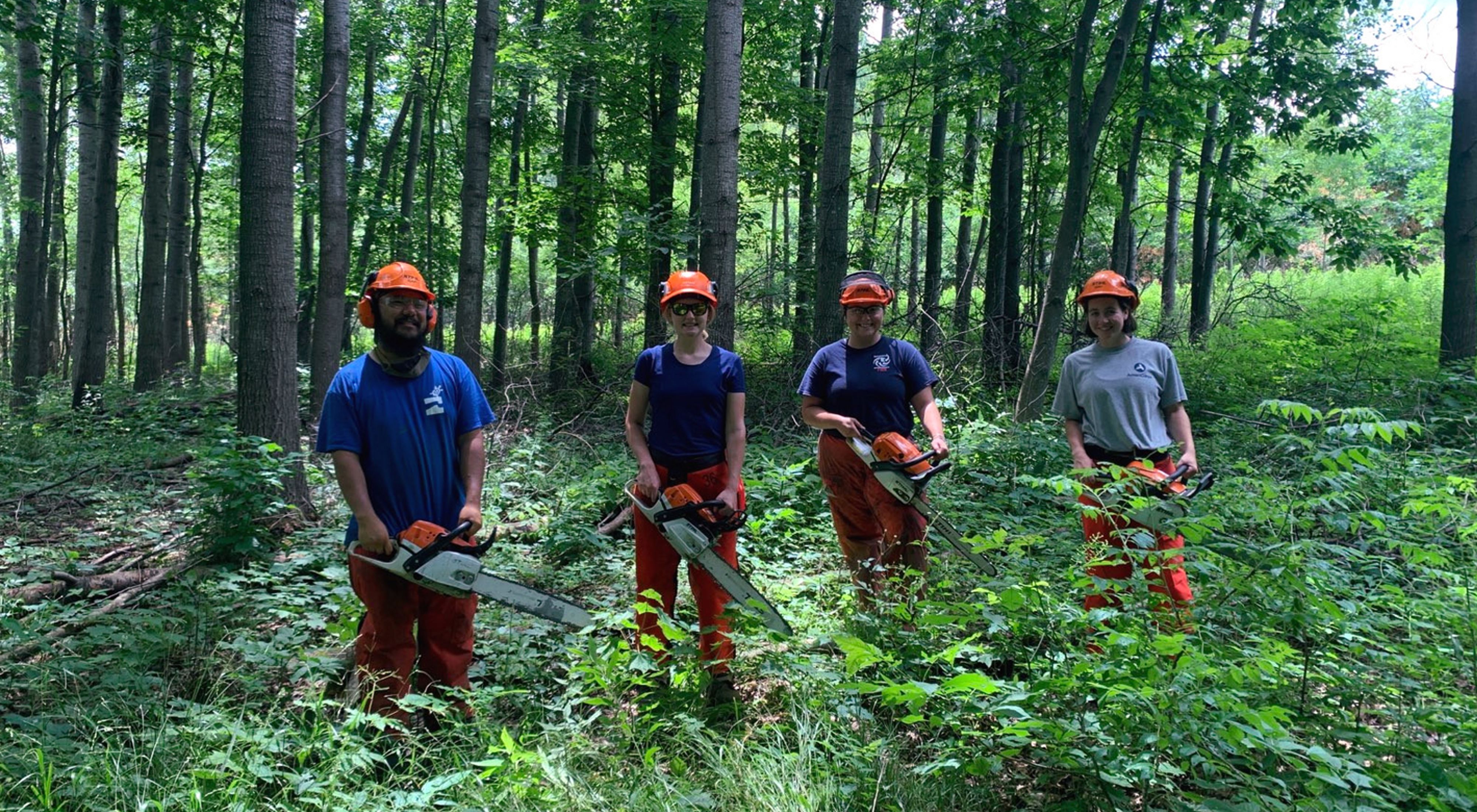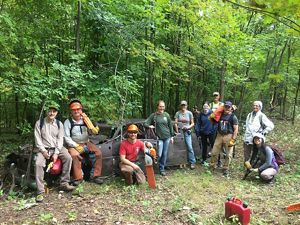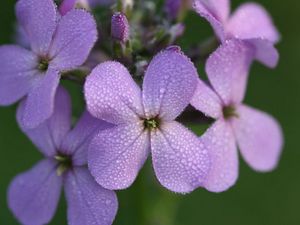Helping Hands for the Land
What happens after TNC purchases land? Learn about the many methods—and people—needed to manage and protect some of our most precious places.
Get more stories like these in your inbox!
Get our monthly Nature News all about TNC's work in Wisconsin.
The sun filters down onto the ground in dappled rays, shadows dancing in reflection of the aspen leaves above. The stand of tall, narrow trees grows in the middle of an otherwise open field at TNC’s Newell and Ann Meyer Nature Preserve. They might be unremarkable save for the narrow bands of bark carved from their trunks. These aspens have been girdled, a technique that avoids the use of herbicides and that will cause them to die, slowly, over the course of a year or two.
Aspens are native to Wisconsin, so a casual observer might find it startling to see a group of them being intentionally killed like this. The process is necessary and important, however, according to Brian Miner, TNC’s Mukwonago Land Manager.
“Aspen are a successional species and will take over an open field, eventually converting it to forest. For instance, here at the Meyer Preserve, this land used to be prairie but was converted for agricultural use. We’ve restored 205 acres of prairie and are working on another 70 acres, which requires removing things like aspens,” Miner says. “They're native, but since we don't want forest in the prairie, we need to remove them.”
The technique isn’t one that leads to instant gratification, but so much of land management work is about longterm, slow-but-steady efforts to help a landscape maintain or return to good health. While the process for purchasing land can take years, the next chapter—stewardship of that land—takes lifetimes. It also takes many forms.
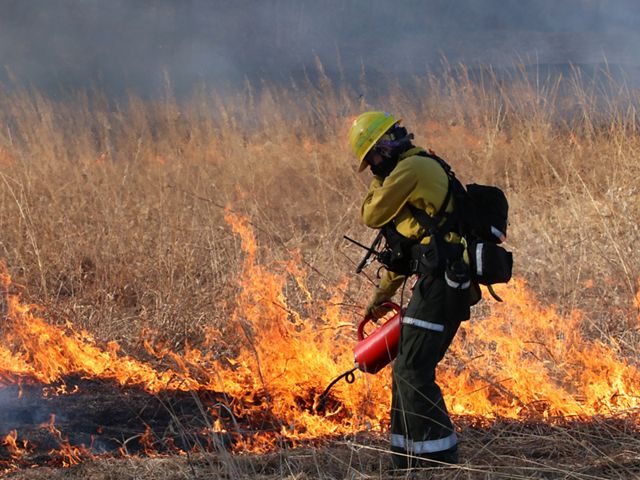
Fighting Fire with Fire
Wisconsin, located at the junction of the eastern deciduous forest, northern boreal forest and temperate grasslands, boasts dozens of natural communities, each with their own unique management needs. Nature Conservancy staff, partners, and volunteers engage in a wide range of techniques to care for the lands and waters entrusted to our stewardship: prescribed fire, forestry mowing, tree planting and thinning, invasive species removal, bio-controls, trash clearing, trail maintenance and more all figure into the mix. The work is intensive, challenging and rewarding.
The science and resulting best practices behind land and water management are always evolving. One major example of changing attitudes is around the presence of fire on a landscape. For a century, land managers focused almost exclusively on suppressing fire. In recent years, however, attitudes have begun to shift, as traditional knowledge, new research, and increasingly deadly wildfire seasons have come together to show the value of prescribed fire in maintaining healthy lands for people and nature.
Caleb Klima, TNC’s Baraboo Hills Land Manager, has witnessed first-hand the consequences of removing fire from the land. He also knows the benefits of bringing it back to Wisconsin’s prairies, forests and wetlands that evolved to rely on that disturbance to thrive.
Klima describes the Baraboo bluff region and adjacent valleys as having formerly been home to vast prairie and oak forest that evolved with natural and human disturbance. That landscape remains a crucial haven for migrating neotropical birds and a corridor for species adapting to a changing climate. All of it evolved to be reliant on fire resulting from lightning strikes and other natural occurrences. Thousands of years prior to European settlement, Indigenous people also used cultural fires to shape the landscape.
“Since European settlement, we took out that disturbance, and in woods east of the Mississippi River we're losing the traditional trees—things like oak and hickory—that used to dominate the landscape.” In their place, maples and other shade-loving trees and plants sprout up, converting dry, sunny ecosystems into wetter, shadier ones.
Fire work requires substantial resources. TNC relies on staff and volunteers from other organizations, as well as members from the AmeriCorps program and seasonal staff, to run carefully planned and orchestrated prescribed burns. Klima, along with Wisconsin Fire Manager John Schwingel and others, have all worked to ramp up TNC’s prescribed fire program in recent years.
“Fire is nature's recycler. It helps with resiliency,” Klima says. “Are we trying to replicate what was here in the past? Not necessarily.” He explains that the goal is to bring back oaks in particular and to restore and maintain a healthy, balanced ecosystem that supports biodiversity and decreases the chances of wildfires.
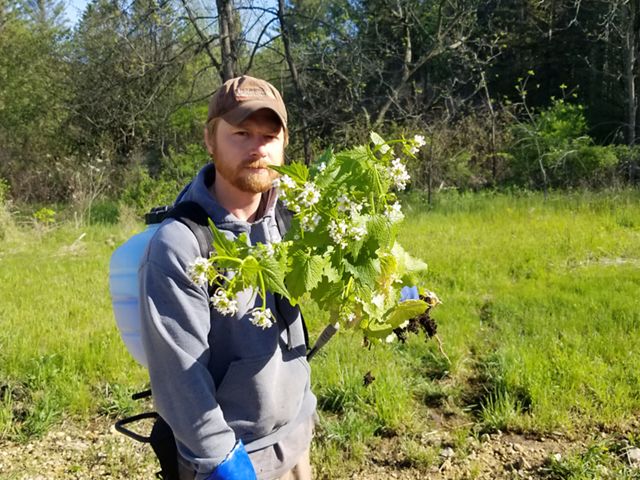
The Battle Against Invasive Species
One of the main tasks for land managers the world over is eradicating or controlling problematic invasive plant and animal species. In Wisconsin, some of the most well-known culprits are garlic mustard, buckthorn and reed canary grass, but there are many other species of concern as well. Invasive species tend to lack the predators that help keep their growth in check. They often grow quickly and crowd out native flora, creating monocultures where there had previously been diversity.
At TNC’s Mukwonago field office, staff have been on the frontlines of efforts to control purple loosestrife, an invasive aquatic plant that’s taken root in the area, including at nearby Lulu Lake Preserve.
For years, staff volunteers, and contractors attempted to control the plant through hand-pulling, a process that is labor- and time-intensive and can result in breaking the plant apart, allowing it to propagate itself even more quickly.
Thankfully, after decades of study, the EPA approved the use of a biological control for purple loosestrife: beetles. Specifically, Galerucella pusilla, the plant’s natural predator in its native habitat around the Mediterranean Sea. The beetle only eats purple loosestrife, avoiding neighboring native plants. TNC staff have been raising the beetles in an enclosure outside the field office in East Troy, releasing a new brood every summer on strategic sites around TNC preserves, as well as giving the bugs out to private landowners and the Wisconsin DNR.
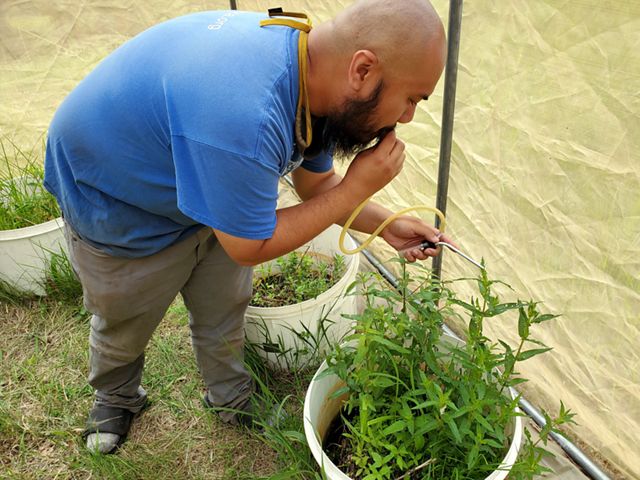
“Since their introduction over a decade ago, the beetles have significantly reduced the amount of purple loosestrife, helping managers avoid the use of chemicals or less effective hand pulling to keep the plant in check,” Miner says.
Not all invasive plants have a safe biological control approved for use. Good old-fashioned elbow grease is still an essential part of managing landscapes beset with things like buckthorn and honeysuckle. In those cases, staff, volunteers and contractors enter the equation. TNC’s new mobile crew, currently a group of three to four people, travels to different locations across the state, often camping out overnight in more remote spots, to help manage TNC’s preserves. A big part of their job is cutting and treating thickets of invasive plants that threaten sensitive ecosystems.
Karina Cardella, TNC’s Land Stewardship Crew Lead, says the difficult work is more than worth it.
“It's one thing to be able to do research and see why an ecosystem works the way it does or how an organism fits into a particular plant community,” she notes. “It's another thing to be out there helping correct what we as humans have done to set things off-kilter. It's amazing how just removing an invasive can create so many changes that facilitate an entire ecosystem being in the state it should be.”
Along with Cardella, the current mobile crew includes Brooke Frederisckson and Brian Walsh. Together, they’ve tackled everything from removing invasive plants to improving trails to planting new trees, providing essential manpower in the continuous task of caring for the land.
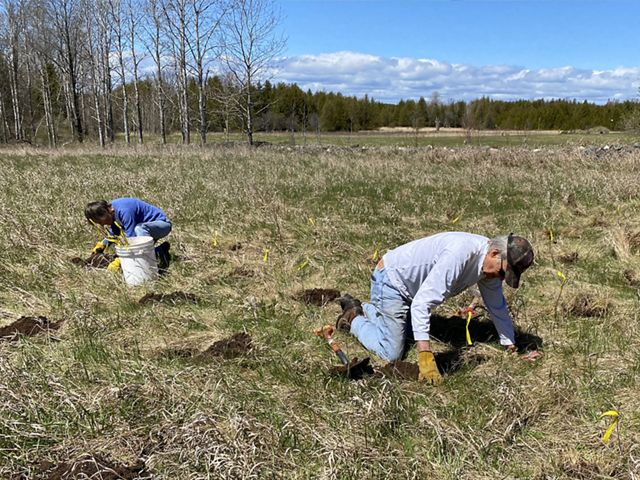
Planting Trees, Protecting Groundwater
Up in Wisconsin’s Door Peninsula, TNC Conservation Ecologist Mike Grimm ticks off the many ways staff, volunteers and partner organizations go about managing land and water in a place with some particularly unique ecosystems where groundwater is of special concern.
“In Door County, most water actually moves vertically rather than horizontally,” explains Grimm. “Soils are so thin at our preserves that water generally percolates down pretty fast into groundwater, and then comes out in seeps and springs.”
Rather than removing trees from open areas as in Mukwonago, the focus on the peninsula is to re-forest old agricultural fields. Over the past 20 years, TNC has planted 150,000 trees on hundreds of acres in Door County. The work helps to reconnect forest blocks, providing crucial habitat for forest species and creating healthier ecosystems overall. Trees also help slow the melt of snow, giving water time to percolate into the ground.
“We get more recharge under a forest canopy than under a hay field,” says Grimm.
Another important part of the job is the removal of garbage and waste from decades ago, when some residents used sinkholes and other natural features as private dumps for waste like antifreeze and oil. Left to rot, the containers leak their toxic contents into wetlands and other groundwater sources.
Volunteers at the Heart of Conservation
The work also relies heavily on volunteers. From the folks who come out to help with tree plantings and trail maintenance days when they can, to the individuals who act as part-time land stewards, volunteers are part of the lifeblood of conservation. In its earliest days, TNC was mostly run by volunteers. Now, paid staff still rely on help from volunteers—of all ages and from a wide variety of backgrounds—to get the important work done.
For example, Rod Sharka has been the local caretaker of TNC’s Guido Rahr, Sr. Tenderfoot Forest Reserve in the Northwoods for decades. Sharka lives near the preserve and checks in on the remote trails, reporting back about needed repairs and doing maintenance to ensure they remain accessible.
“The day that Rod reached out to us more than 15 years ago to volunteer at Tenderfoot was the start of a relationship that, through Rod, has connected hundreds of people to nature and has resulted in the Tenderfoot property being nearly invasive-free,” says Matt Dallman, TNC Wisconsin’s deputy state director.
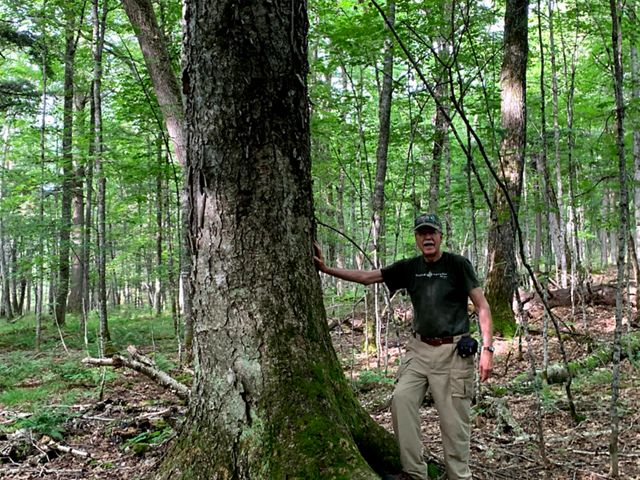
Creating a More Connected World
Ultimately, the purpose of all the hard work that goes into land and water management is to create a more connected and resilient world, one that benefits nature and people.
“Maintaining healthy, functioning biodiverse areas across the landscape all adds up,” explains Ann Calhoun, TNC Wisconsin’s Baraboo Hills Project Coordinator. “Efforts to protect sites that connect helps maintain corridors for species to move across the landscape, which is especially crucial as our climate changes.”
“I think of our work as maintaining a diverse investment portfolio in the face of climate change,” adds Calhoun. “As we’re already seeing, these lands are likely to face a variety of stressors in the future, and there will be winners and losers. However, the more diversity of species that are present and the more resilient and connected the landscapes are, the more options are maintained for plants and animals to be able to survive, shift, and fill different niches in a changing climate.”
